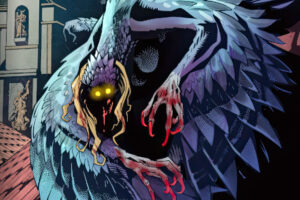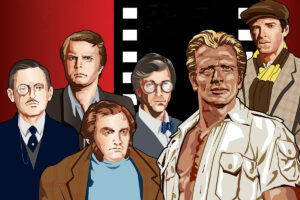 It’s summer 2017, and that means a new Pulpfest and a new issue of The Pulpster, #26!
It’s summer 2017, and that means a new Pulpfest and a new issue of The Pulpster, #26!
The main focus of this issue is “dangerous dames” and “psychos.” The first seems apropos, what with the recent Wonder Woman tearing up the movie screens. But Wonder Woman is not pulp. Who, then are some of the dangerous dames of the pulps?
Well, Ron Goulart and Bill Pronzini provide us with a pair of articles on that.
Ron is up first with a look at some of the few female detectives from the pulps, many that I wasn’t aware of. There is Madame Storey who appeared in Argosy and Mystery in the 1920s and ’30s. Violet McCade appeared in Street & Smith’s Clues Detective Stories in 1935-37 (around the same time as I.V. Frost). Longer running is Theodore Tinsley‘s Carrie Cashin who appeared in S&S’s tryout pulp Crime Busters (later renamed Street & Smith’s Mystery Magazine) for nearly 40 stories from 1937 to ’42, the whole run of the magazine. Then we have Sarah Watson in Detective Fiction Weekly from 1935-38. Finally, and surprisingly, we have Sally the Sleuth, who starred in short two-page comic stories in the spicy pulps where she often lost most of her clothes. Sadly, none of these are readily available today. I keep hoping Sanctum Books would at least reprint some Carrie Cashin.
Bill’s article is a flipside to that one. Here he examines female authors who wrote for the detective pulps. Now, I take exception to his listing of Marjory Stoneman Douglas as a long-forgotten name. He’s obviously not from Florida, where Douglas is well known in South Florida for her work saving the Everglades. As I’m not that into detective and mystery stories, most of the names I’m not familiar with. I was surprised to see Leigh Brackett listed, as I only know her as a science-fiction writer. (Please note that this article was a reprint from 1998, and Ron’s is reprinted from his book The Dime Detectives).
And what about “psychos”? Here we get an article on Robert Bloch by professor Garyn Roberts. While he is best known (or probably to most people only known) as the author of Psycho, used as the basis for the Alfred Hitchcock movie (and later sequels and a recent prequel TV series), Bloch got his start in the pulps. An early correspondent with H.P. Lovecraft and others, he broke into the field getting published in Weird Tales. While I’ve never read Psycho, I have read his Lovecraftian works.
Tony Davis provides an look at horror author and poet Mary Elizabeth Counselman, who had 30-some stories and poems published in Weird Tales at an early age (please note, she was born in 1911, not 1921). And she apparently stayed active with fandom into the 1960s and ’70s, even publishing her own fanzine. Arkham House published a collection of her works.
We have an interesting article on pulp preservation (and restoration) by Curt Philips. This is kind of why I don’t get into collecting the original pulps. I more want to read the stories, and so worry about ruining the magazines or not being able to store them properly.
Another article looks at Detective Story Weekly, the “lesser” of the big three of detective/crime pulps (Black Mask and Dime Detective being the other two). It was interesting to learn more about this long running pulp.
Paperbacks “saving” the pulps is the topic of another article. I’ve long pointed out to people that they may have read pulp fiction without knowing it, as many pulp works were reprinted in the paperbacks. I was reading a lot of pulp sf in my early years (Burroughs, Heinlein, et al), then got into the paperback reprints of the pulp heroes.
Monte Herridge provides another article on another obscure character. The offbeat detective stories of Captain McGill that ran for about a dozen stories in Detective Fiction Weekly from 1939-43. Richard Sale (who created Daffy Dill in the same pulp, as well as The Cobra) wrote this series.
Finally, we get a roundup of those who have passed away recently. Robert Weinberg is noted, and we get an overview of his many works. Several I have reviewed here, and a few will be forthcoming.
As always, a great issue. Even if you can’t get to Pulpfest, get this issue of The Pulpster.




My deceased husband, Charles Boeckman (aka Charles Beckman), wrote for the pulps. He was very versatile and also made good money writing for women’s confession magazines, which had no byline. He wrote some Alfred Hitchcock stories. In the mid 1980’s, we both wrote Silhouette Romances. We actually launched that line. What happened was that we attended a writer’s conference where we heard a presentation about a new line of romance books. The editors were looking for submissions. When we got home, my husband wrote a proposal and sent it in. We received a phone call from an editor who told us that she had received a lot of submissions, but they hadn’t received even one that they could use until they received ours. They were so excited and asked for another proposal, which would get us a contract for both books and a nice advance. We eventually wrote 25 romance novels for them. From pulps to romances and everything in between.